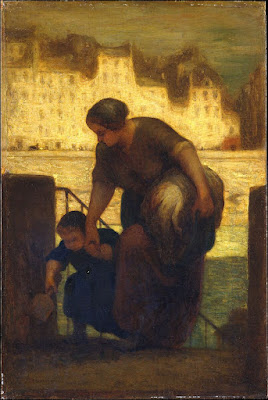This is one of the most widespread laundress paintings of the Impressionist era. Model Nini Lopez, who posed for many of Renoir's paintings, is depicted as a laundress standing in front of an open door. His hurried brush strokes make her features barely discernible, as Renoir is not creating a portrait but a character. The bare shoulder and rosy cheeks catch the viewers eye and would easily allow one to believe that she is a prostitute. However, the laundry basket at her feet points to her career as a laundress. Unlike many Impressionist painters who made many paintings of the laundress, this is thought to be the only one Renoir completed.
Drawing inspiration from Japanese Ukiyo-e art, Degas pulls the viewer close into the world of this laundress whose face is turned so the focus is not on her but on her task and the repetitive movement of the iron. The bright white of the fabric against the silhouetted figure returns focus to the laundress. The fabric that the woman is ironing is indiscernible. He does not seek to glorify her task but simply gives viewers a blurred snapshot of the working woman. This is just one of a series of a woman ironing that Degas paints.
Here, Degas switches his focus from the task of ironing to the laundress herself. Degas shows the physical demand of the strenuous job through the woman on the right, who has her whole body involved in the movement. Juxtaposed is the woman on the right who is yawning, stretching, and clutching a bottle of wine. Degas is both portraying the stereotype seen in L'Assommoir, and the reality of the work, without emphasizing one over the other. This is one in a series of two laundresses at work that Degas does.
Daumier captures a laundress and her daughter returning from retrieving a load of laundry from a boat on the Seine. He creates a reverse "spotlight" effect with the sun shining from the left onto the buildings in the background and the subjects under a shadow. In one hand, the mother carries the load of laundry and in the other, the hand of her daughter who walks slightly behind her. She looks down at her daughter, helping her up the steps. Daumier humanizes the woman, making her a mother as well as a laundress. The presence of the little girl also foreshadows that she will likely one day be in the same footsteps as her mother.
This is one of a series of four illustrations that Renoir created for Émile Zola’s L’Assommoir. This illustration depicts Nana, the daughter of the laundress in Zola’s novel. In this scene, Nana is seen with her friends in a rare moment of innocence and joy. While she is seen as young and pure in this illustration, she becomes the subject for Zola’s next book. In this novel, Nana also attempts the career of a laundress. However, like her mother, she is sucked into extreme poverty and despair and becomes a prostitute as Zola continues his doomed laundress narrative.





No comments:
Post a Comment